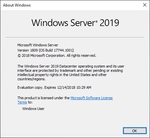Windows Server 2019 build 17744
| Build of Windows Server 2019 | |
 | |
| OS family | Windows 10 (NT 10.0) |
|---|---|
| Version number | 10.0 |
| Build number | 17744 |
| Build revision | 1001 |
| Architecture | x64 |
| Build lab | rs5_release |
| Compiled on | 2018-08-18 |
| Expiration date | |
| Timebomb | 2018-12-14 (+118 days) |
| SKUs | |
| Standard Server Standard Server Core Datacenter Server Datacenter Server Core Hyper-V Server | |
| About dialog | |
Windows Server 2019 build 17744 is the twelfth Insider Preview build of Windows Server 2019. It was released on 28 August 2018.
New features and changes[edit | edit source]
- The Hyper-V Server SKU now no longer prompts for a product key, and administrators are now properly prompted to change their passwords when signing-in for the first time, as well as updated installation branding.
- Added some additional features in the Hyper-V SKU, such as failover clustering hardening (the use of NTLM is no longer required to use failover clustering), Server Message Block (SMB) hardening (SMB 1.0 is disabled by default), added the Windows Subsystem for Linux, Windows Defender Advanced Threat Protection and the .NET Framework version 4.7.
- Hyper-V Server can now be fully managed by Windows Admin Center.
Bugs[edit | edit source]
- After a system running Standard Server Core is transitioned (transmogrified) to the Datacenter Server Core SKU, done by executing
dism /online /setedition:ServerDatacenterCor /ProductKey:product-key/AcceptEula, the operating system will enter a non-licensed state. On an affected system, the user is not instructed to restart the system, and the OS indicates that it is a retail channel version rather than a Generic Volume License Key (GVLK) version, even when the product key is a GVLK key. To make an affected system licensed again, run the following command:cscript c:\Windows\System32\slmgr.vbs /ipkproduct-key - On the Italian-language versions of the Hyper-V Server SKU, the text of the EULA is formatted incorrectly.
- The operating system has an unnecessary utility account for Windows Defender Application Guard.
- Authentication that uses Public Key Cryptography User-to-User (PKU2U) to access an SMB volume can result in the error
STATUS_LOGON_FAILURE. This is due to an invalid private key in the certificate for a cluster-created user account (CSUSR) on each of the cluster nodes. It can cause cross-cluster migration in cluster sets to fail, as well as possibly cause global namespace mappings to fail, which in turn leads to virtual machines being unable to access storage. - The Base Filtering Engine service may consume an unusually large amount of memory after starting and stopping thousands of containers.
- The system may crash with a
SYSTEM_THREAD_EXCEPTION_NOT_HANDLEDblue screen of death in the Virtual Hard Disk Miniport Driver (Vhdmp.sys). - When a Windows Defender Application Guard container crashes, the resulting type of dump may be unexpected.
- Database applications might not be able to initialize a database and fail with either a stack overflow or insufficient privileges error when the database is located on an SMB volume.
- Shielded VMs running Linux do not boot because the loader (LSVMLoad) waits for a passphrase for the boot partition.
- In the Nano SKU, creating or modifying environment variables by using
setxwill fail. This is becausesetxrequires theHKCU\Environment\to be present by default. To fix this issue, change where this variable is stored in the registry, or add the expected registry path before you execute asetxcommand. To specify that the variable be set for system-wide use in HKLM rather than in HKCU, which is the default, add the/Mswitch to asetxcommand. To add the expected registry path, runreg add HKCU\Environmentbefore executing a setx command.
SKUs and keys[edit | edit source]
| Edition / SKU Name | Key |
|---|---|
| Standard Server | MFY9F-XBN2F-TYFMP-CCV49-RMYVH |
| Datacenter Server | 6XBNX-4JQGW-QX6QG-74P76-72V67 |


